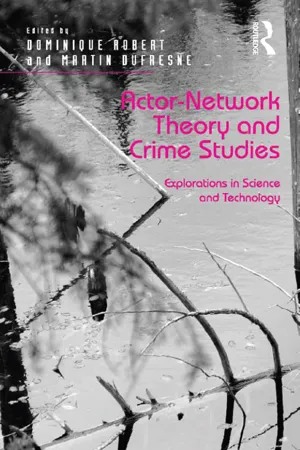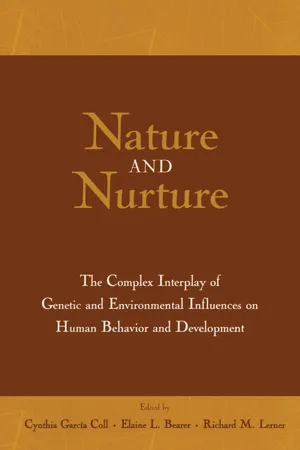Caspi et al 2003
"Caspi et al 2003" refers to a landmark study that investigated the interplay between genetics and environment in shaping human behavior. The study focused on the role of a specific gene variant in influencing individuals' susceptibility to stress and subsequent development of depression. The findings highlighted the complex interaction between genetic predisposition and life experiences in determining mental health outcomes.
6 Key excerpts on "Caspi et al 2003"
- eBook - ePub
- Ming T. Tsuang, Mauricio Tohen, Peter Jones, Ming T. Tsuang, Mauricio Tohen, Peter Jones(Authors)
- 2011(Publication Date)
- Wiley(Publisher)
...Am. J. Psychiatry, 163 (10), 1683–1694. [25] Plomin, R., DeFries, J.C. and Loehlin, J.C. (1977) Genotype-environment interaction and correlation in the analysis of human behaviour. Psychol. Bull., 84, 309–322. [26] Kenneth, K.S., Gardener, C.O. and Prescott, C.A. (2003) Personality and the experience of environmental adversity. Psychol. Med., 33, 1193–1202. [27] Spinath, F.M. and O'Connor, T. (2003) A behavioural genetic study of theoverlap between personality and parenting. J. Pers., 71, 785–808. [28] Kenneth, K.S. and Baker, J.H. (2007) Genetic influences on measures of the environment: a systematic review. Psychol. Med., 37, 615–626. [29] Rutter, M. (2006) Genes and Behaviour: Nature–Nurture Interplay Explained, Blackwell, Oxford. [30] Rutter, M. (2008) Biological implications of gene–environment interaction. J. Abnorm. Child Psychol., 36, 969–975. [31] Rutter, M. (2006) Implications of resilience concepts for scientific understanding. Ann. N. Y. Acad. Sci., 1094, 1–12. [32] Uher, R. (2008) Gene–environment interaction: overcoming methodological challenges, in Genetic Effects on Environmental Vulnerability to Disease (ed. M. Rutter), John Wiley & Sons, Ltd, Chichester, pp. 13–30. [33] Moogavkar, S.H. (2004) Fifty years of the multistage model:remarks on a landmark paper. Int. J. Epidemiol., 33, 1182–1183. [34] Rothman, K.J., Greenland, S., Poole, C. and Lash, T.L. (2008) Causation and causal inference, in Modern Epidemiology (eds K.J. Rothman and T.L. Lash), Lippincott Williams & Wilkins, Philadelphia, pp. 5–31. [35] North, K.E. and Martin, L.J. (2008) The importance of gene–environment interaction: implications for social scientists. Sociol. Methods Res., 37 (2), 164–200. [36] Neale, B.M. and Sham, P.C. (2004) The future of association studies. Gene-based analysis and replication. Am. J. Hum. Genet., 75, 353–362. [37] Zhang, K., Qin, Z.S., Liu, J.S. et al...
- eBook - ePub
Actor-Network Theory and Crime Studies
Explorations in Science and Technology
- Dominique Robert, Martin Dufresne(Authors)
- 2016(Publication Date)
- Routledge(Publisher)
...In epigenetic language, genetic expression (phenotype – behaviour) may be modulated by the environment. Therefore, the one-to-one gene-phenotype deterministic relation – a Mendelian causality, as, for example, in the case of eye colour – is replaced by a more complex interaction between biology and environment. For Beaver and Walsh: This approach is not a throwback to the outdated nature versus nurture debate. Instead, the biosocial perspective recognizes the exquisite complexity of human behaviour and thus focuses on the various ways in which biological/genetic factors interface with environmental factors to produce differing propensities for antisocial behaviours (2011: 5). The direct and deterministic relationship is also softened as research today embraces a broader causality, one comprised of risk factors, associations, and correlates. For example, Walsh explains that they are not working on crime, but on what is associated with antisocial behaviour. For example, sensation-seeking, egoism, are “traits that increase the probability of criminal behaviour, more so in some environments than in others” (2009: 9). Therefore, it is no surprise that correlation studies should continue to multiply, as the list of correlates of crime seems to be infinite (for example, Ellis, Beaver and Wright 2009). Repeatedly mentioned as reflective of this “paradigmatic shift” and as a staple of the GxE approach, the Caspi study, published in Science in 2002, rekindled the debate over the intergenerational cycle of violence. Their work amalgamates two research streams, one on the intergenerational transmission of violence, the other on the genetics of neurotransmission involving the Monoamine oxidase-A gene and aggressive behaviour...
- eBook - ePub
- Y. Kovas, S. Malykh, D. Gaysina, Y. Kovas, S. Malykh, D. Gaysina(Authors)
- 2016(Publication Date)
- Palgrave Macmillan(Publisher)
...The development of more focused (family or person-oriented) prevention programmes for decreasing the risks of problem behaviour or psychopathology on the basis of individual genetic (or gene–environment) screening is a reality of the near future. Genetic factors that contribute to the risks or protect from the risks in specific adverse environments, once identified, will be used to design evidence-based psychological services and individualized educational programmes. References Abrahamson, A. C., Baker, L. A., & Caspi, A. (2002). Rebellious teens? Genetic and environmental influences on the social attitudes of adolescents. Journal of Personality and Social Psychology, 83 (6), 1392–1408. Asbury, K., Dunn, J. F., Pike, A., & Plomin, R. (2003). Nonshared environmental influences on individual differences in early behavioral development: A monozygotic twin differences study. Child Development, 74 (3), 933–943. Beaver, K. M., Shutt, J. E., Vaughn, M. G., DeLisi, M., & Wright, J. P. (2012). Genetic Influences on Measures of Parental Negativity and Childhood Maltreatment: An Exploratory Study Testing for Gene × Environment Correlations. Journal of Contemporary Criminal Justice, 28 (3), 273–292. Belsky, J., & Pluess, M. (2009). Beyond diathesis stress: differential susceptibility to environmental influences. Psychological Bulletin, 135 (6), 885–908. Billig, J. P., Hershberger, S. L., Iacono, W. G., & McGue, M. (1996). Life events and personality in late adolescence: genetic and environmental relations. Behavior Genetics, 26 (6), 543–554. Bokhorst, C. L., Bakermans–kranenburg, M. J., Fonagy, P., & Schuengel, C. (2003). The importance of shared environment in mother–infant attachment security: A behavioral genetic study. Child Development, 74 (6), 1769–1782. Borinskaya, S., Kal’ina, N., Marusin, A., Faskhutdinova, G., Morozova, I., Kutuev, I., ... & Rogaev, E. (2009)...
- eBook - ePub
- Marc H. Bornstein, Jerome S. Bruner, Marc H. Bornstein, Jerome S. Bruner(Authors)
- 2014(Publication Date)
- Psychology Press(Publisher)
...These types of analyses have important implications for intervention research: By identifying interactions in which individuals with certain genetic propensities are affected differently by environmental factors, a new perspective for understanding environmental influences on individual development emerges. That is, if certain types of interactions can be attributed to specific behavioral and environmental measures, interventions can be directed at populations most likely to benefit. References Anastasi, A. Heredity, environment, and the question "How?". Psychological Review, 1958, 65, 197–208. Bay Ley, N. Manual for the Bay ley scales of infant development. New York: Psychological Corporation, 1969. Bergeman, C. S. Genotype-environment interaction in temperament development: Identical twins reared apart. Unpublished Master's Thesis, Pennsylvania State University, 1987. Bergeman, C. S., Plomin, R., McClearn, G. E., Pedersen, N. L., & Friberg, L. T. Genotype-environment interaction in personality development: Identical twins reared apart. Psychology and Aging, 1988, vol. 3, 399–406. Caldwell, B. M., & Bradley, R. H. Home observation for measurement of the environment. Little Rock, University of Arkansas, 1978. Cohen, J., & Cohen, P. Applied multiple regression/correlation analysis for the behavioral sciences. New York: Halsted Press, 1975. Cooper, R. M., & Zubek, J. P. Effects of enriched and restricted early environments on the learning ability of bright and dull rats, Canadian Journal of Psychology, 1958, 12, 159–164. Ehrman, L., & Parson, P. A. The genetics of behavior. Sunderland, MA: Sinauer Associates, 1981. Erlenmeyer-Kimling, L. Gene-environment interaction and the variability of behavior. In L.Ehrman, G.Omenn, & E.Caspari (Eds.), Genetics, environment, and behavior: Implications for educational policy...
- eBook - ePub
Nature and Nurture
The Complex Interplay of Genetic and Environmental Influences on Human Behavior and Development
- Cynthia Garcia Coll, Elaine L. Bearer, Richard M. Lerner, Cynthia Garcia Coll, Elaine L. Bearer, Richard M. Lerner(Authors)
- 2014(Publication Date)
- Psychology Press(Publisher)
...Investigating the impact of genetic and environmental influences on human development, and the processes involved in mediating these influences, poses perhaps the most fundamental question we can ask about human nature. The nature–nurture question continues to gamer attention, and with the swift progress of the Human Genome Project, interest in this issue will only grow. Historically, the intellectual battleground between hereditarians and environmentalists spanned a variety of academic disciplines, including psychology, sociology, and anthropology, along with professional realms such as education and medicine. The primary debate, in the eyes of the public, was whether nature or nurture was responsible for a given outcome. In later years, the focus shifted from contention to cooperation; rather than asking whether genetic or environmental factors determine a given outcome, researchers recognized the importance of both (Plomin, 1996). Although still often misunderstood by the public, the realization that both heredity and environment play a role in practically all human behavior superseded myopic notions such as genetic determinism or strict environmentalism. Thus, through methods such as twin and adoption studies, behavioral geneticists began to study the relative impact of heredity and environment on human behavior (see Plomin, DeFries, McClearn, & McGuffin, 2001). Social scientists have also recognized, however, that the calculation of heritabilities for traits and the partitioning of variance into genetic and environmental components—the traditional domain of behavioral genetics—is of limited value (Bronfenbrenner & Ceci, 1994; Turkheimer, 1998). While it may be useful to know, the determination of how much variance is accounted for by genetic and environmental factors does not reveal how the two interact to yield developmental outcomes...
- eBook - ePub
The SAGE Handbook of Evolutionary Psychology
Integration of Evolutionary Psychology with Other Disciplines
- Todd K. Shackelford(Author)
- 2020(Publication Date)
- SAGE Publications Ltd(Publisher)
...P., Cesarini, D., Johannesson, M., van der Loos, M. J. H. M., Koellinger, P. D., Groenen, P. J. F., Fowler, J. H., Rosenquist, J. N., Thurik, A. R., & Christakis, N. A. (2011). Molecular genetics and economics. Journal of Economic Perspectives, 25, 57 – 82. Beaver, K. M. (2009). Biosocial criminology: A primer. (2nd ed.). Dubuque : Kendall Hunt Publishing. Beaver, K. M. (2011). Genetic influences on being processed through the criminal justice system: Results from a sample of adoptees. Biological Psychiatry, 69, 282 – 287. Belsky, J., Steinberg, L., & Draper, P. (1991). Childhood experience, interpersonal development, and reproductive strategy: An evolutionary theory of socialization. Child Development, 62, 647 – 670. Briley, D. A., & Tucker-Drob, E. M. (2013). Explaining the increasing heritability of cognitive ability across the development: A meta-analysis of longitudinal twin and adoption studies. Psychological Sciences, 24, 1704 – 1713. Buchanan, J. P., McGue, M., Keyes, M., & Iacono, W. G. (2009). Are there shared environmental influences on adolescent behavior? Evidence from a study of adoptive siblings. Behavior Genetics, 39, 532 – 540. Buss, D. M. (2009). How can evolutionary psychology successfully explain personality and individual differences? Perspectives on Psychological Science, 4, 359 – 366. Buss, D. M., & Shackelford, T. K. (1997). Human aggression in evolutionary psychological perspective. Clinical Psychology Review, 17, 605 – 619. Caspi, A., McClay, J., Moffitt, T. E., Mill, J., Martin, J., Craig, I. W., Taylor, A., & Poulton, R. (2002). Role of genotype in the cycle of violence in maltreated children. Science, 287, 851 – 854. Caspi, A., Moffitt, T...





